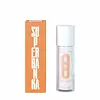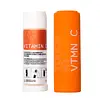What's inside
What's inside
 Key Ingredients
Key Ingredients

 Benefits
Benefits

 Concerns
Concerns

 Ingredients Side-by-side
Ingredients Side-by-side

Water
Skin ConditioningPentylene Glycol
Skin ConditioningAscorbyl Tetraisopalmitate 4%
AntioxidantPrunus Amygdalus Dulcis Oil
Skin ConditioningSimmondsia Chinensis Seed Oil
EmollientGlycerin
HumectantTrehalose
HumectantSqualane
EmollientPanthenol
Skin ConditioningC12-13 Alkyl Lactate
EmollientGlycine Soja Seed Extract
Skin ConditioningPhospholipids
Skin ConditioningTranexamic Acid 1%
AstringentGlycine Soja Oil
EmollientNiacinamide 1%
SmoothingGlycolipids
Skin ConditioningGlyceryl Glucoside
HumectantGlycine Soja Sterols
EmollientCopper Tripeptide-1 1%
Skin ConditioningGlyceryl Stearate
EmollientTocopherol
AntioxidantBeta-Sitosterol
Emulsion StabilisingSodium Hyaluronate
HumectantXanthan Gum
EmulsifyingLecithin
EmollientSclerotium Gum
Emulsion StabilisingPullulan
Phytic Acid
Lactic Acid
BufferingWater, Pentylene Glycol, Ascorbyl Tetraisopalmitate 4%, Prunus Amygdalus Dulcis Oil, Simmondsia Chinensis Seed Oil, Glycerin, Trehalose, Squalane, Panthenol, C12-13 Alkyl Lactate, Glycine Soja Seed Extract, Phospholipids, Tranexamic Acid 1%, Glycine Soja Oil, Niacinamide 1%, Glycolipids, Glyceryl Glucoside, Glycine Soja Sterols, Copper Tripeptide-1 1%, Glyceryl Stearate, Tocopherol, Beta-Sitosterol, Sodium Hyaluronate, Xanthan Gum, Lecithin, Sclerotium Gum, Pullulan, Phytic Acid, Lactic Acid
Water
Skin Conditioning3-O-Ethyl Ascorbic Acid 15%
Skin ConditioningGlycerin
HumectantLactobacillus/Punica Granatum Fruit Ferment Extract
Skin ConditioningAscorbyl Tetraisopalmitate 3%
AntioxidantTrehalose
HumectantDi-C12-13 Alkyl Malate
EmollientCetearyl Alcohol
EmollientPhosphatidylcholine
EmulsifyingDimethicone
EmollientC12-13 Alkyl Lactate
EmollientCyclopentasiloxane
EmollientPhenoxyethanol
PreservativeAmmonium Acryloyldimethyltaurate/Vp Copolymer
Tocopheryl Acetate
AntioxidantPotassium Cetyl Phosphate
EmulsifyingBis-Ethylhexyl Hydroxydimethoxy Benzylmalonate
AntioxidantMethylparaben
PreservativeEthylparaben
PreservativePropylparaben
PreservativeAlgin
MaskingLactic Acid
BufferingSuccinic Acid
BufferingWater, 3-O-Ethyl Ascorbic Acid 15%, Glycerin, Lactobacillus/Punica Granatum Fruit Ferment Extract, Ascorbyl Tetraisopalmitate 3%, Trehalose, Di-C12-13 Alkyl Malate, Cetearyl Alcohol, Phosphatidylcholine, Dimethicone, C12-13 Alkyl Lactate, Cyclopentasiloxane, Phenoxyethanol, Ammonium Acryloyldimethyltaurate/Vp Copolymer, Tocopheryl Acetate, Potassium Cetyl Phosphate, Bis-Ethylhexyl Hydroxydimethoxy Benzylmalonate, Methylparaben, Ethylparaben, Propylparaben, Algin, Lactic Acid, Succinic Acid
Ingredients Explained
These ingredients are found in both products.
Ingredients higher up in an ingredient list are typically present in a larger amount.
Ascorbyl Tetraisopalmitate is a version of ascorbic acid, or Vitamin C.
This ingredient has many benefits including reducing wrinkles, skin soothing, dark spot fading, and fighting against free radicals.
It helps with dark spot fading by interfering with the process of skin darkening, helping to reduce hyperpigmentation. Like other forms of vitamin C, this ingredient encourages the skin to create more collagen.
As an antioxidant, it helps fight free-radicals. Free-radicals are molecules that may damage your skin cells.
One study found Ascorbyl Tetraisopalmitate to degrade in sunlight, but is stabilized when combined with acetyl zingerone.
Learn more about Ascorbyl TetraisopalmitateWe don't have a description for C12-13 Alkyl Lactate yet.
Glycerin is already naturally found in your skin. It helps moisturize and protect your skin.
A study from 2016 found glycerin to be more effective as a humectant than AHAs and hyaluronic acid.
As a humectant, it helps the skin stay hydrated by pulling moisture to your skin. The low molecular weight of glycerin allows it to pull moisture into the deeper layers of your skin.
Hydrated skin improves your skin barrier; Your skin barrier helps protect against irritants and bacteria.
Glycerin has also been found to have antimicrobial and antiviral properties. Due to these properties, glycerin is often used in wound and burn treatments.
In cosmetics, glycerin is usually derived from plants such as soybean or palm. However, it can also be sourced from animals, such as tallow or animal fat.
This ingredient is organic, colorless, odorless, and non-toxic.
Glycerin is the name for this ingredient in American English. British English uses Glycerol/Glycerine.
Learn more about GlycerinLactic Acid is another well-loved alpha hydroxy acid (AHA). It is gentler than glycolic acid but still highly effective.
Its main role is to exfoliate the surface of the skin by loosening the “glue” that holds dead skin cells together. Shedding those old cells leads to smoother, softer, and more even-toned skin.
Because lactic acid molecules are larger than glycolic acid, they don’t penetrate as deeply. This means they’re less likely to sting or irritate, making it a great choice for beginners or those with sensitive skin.
Like glycolic acid, it can:
Lactic acid also acts as a humectant (like hyaluronic acid). It can draw water into the skin to improve hydration and also plays a role in the skin's natural moisturizing factor (NMF) in the form of sodium lactate.
Studies show it can boost ceramide production to strengthen the skin barrier and even help balance the skin’s microbiome.
To get results, choose products with a pH between 3-4.
Lower strengths (5-12%) focus on surface exfoliation; higher strengths (12% and up) can reach deeper in the dermis (deeper, supportive layer) to improve skin texture and firmness over time.
Though it was originally derived from milk, most modern lactic acid used in skincare is vegan. It is made through non-dairy fermentation to create a bio-identical and stable form suitable for all formulations.
When lactic acid shows up near the end of an ingredient list, it usually means the brand added just a tiny amount to adjust the product’s pH.
Legend has it that Cleopatra used to bathe in sour milk to help reduce wrinkles.
Lactic acid is truly a gentle multitasker: it exfoliates, hydrates, strengthens, and brightens. It's a great ingredient for giving your skin a smooth, glowing, and healthy look without the harshness of stronger acids.
Read more about some other popular AHA's here:
Learn more about Lactic AcidTrehalose is a disaccharide made of two glucose molecules (glucose is sugar!). Trehalose is used to help moisturize skin. It also has antioxidant properties.
As a humectant, trehalose helps draw moisture from the air to your skin. This helps keep your skin hydrated.
Due to its antioxidant properties, trehalose may help with signs of aging. Antioxidants help fight free-radical molecules, unstable molecules that may damage your skin.
In medicine, trehalose and hyaluronic acid are used to help treat dry eyes.
Some animals, plants, and bacteria create trehalose as a source of energy to survive freeze or lack of water.
Learn more about TrehaloseWater. It's the most common cosmetic ingredient of all. You'll usually see it at the top of ingredient lists, meaning that it makes up the largest part of the product.
So why is it so popular? Water most often acts as a solvent - this means that it helps dissolve other ingredients into the formulation.
You'll also recognize water as that liquid we all need to stay alive. If you see this, drink a glass of water. Stay hydrated!
Learn more about Water